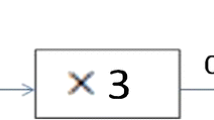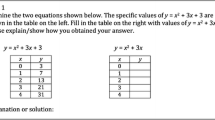Abstract
Research has identified some sources of student difficulty in understanding the horizontal translation of a function. The present study presents and focuses on another source for the difficulties: student conceptions of symbols involved in the horizontal translation of the graph of a function. We explored which student conceptions of the symbols f, x, and y are problematic or supportive in finding the equation of the translated graph when a given graph of y = f(x) is translated −2 units horizontally. For example, student conceptions of x as a general label for any point on the x-axis or as an independent variable of only a given original function emerged as problematic, while a conception of x as an independent variable of a function to describe was supportive. It seemed crucial for students to recruit some background ideas about horizontal translation in order to activate the supportive conceptions of f, x, and y and make them powerful. Our study suggests that horizontal translation of the graph of a function provides an opportunity for students to reflect on their prior conceptions of f, x, and y and restructure the conceptions to be comprehensive.










Similar content being viewed by others
Notes
In this study, we use the phrase “horizontal translation of a function or y = f(x)” rather than “horizontal translation of the graph of a function or y = f(x)” for convenience.
Amy used f ′ to represent the translated graph. In this paper, f ′ has nothing to do with the derivative of f.
References
Arcavi, A. (1994). Symbol sense: Informal sense-making in formal mathematics. For the Learning of Mathematics, 14(3), 24–35.
Arcavi, A. (2003). The role of visual representations in the learning of mathematics. Educational Studies in Mathematics, 52, 215–241.
Arcavi, A. (2005). Developing and using symbol sense in mathematics. For the Learning of Mathematics, 25(2), 42–47.
Ayers, T., Davis, G., Dubinski, E., & Lewin, G. (1988). Computer experiences in learning composition of functions. Journal for Research in Mathematics Education, 19(3), 246–259.
Baker, B., Hemenway, C. & Trigueros, M. (2001). On transformations of basic functions. In H. Chick, K. Stacey, J. Vincent & J. Vincent (Eds.), Proceedings of the 12th ICMI study conference: The future of the teaching and learning of algebra (Vol. 1, pp. 41–47). University of Melbourne.
Borba, M. C., & Confrey, J. (1996). A student’s construction of transformations of functions in a multi representational environment. Educational Studies in Mathematics, 31(3), 319–337.
Breidenbach, D., Dubinsky, E., Hawks, J., & Nichols, D. (1992). Development of the process conception of function. Educational Studies in Mathematics, 23, 247–285.
Charmaz, K. (2006). Constructing grounded theory: A practical guide through qualitative research. Sage.
Dilling, F., & Witzke, I. (2020). The use of 3D-printing technology in calculus education: Concept formation processes of the concept of derivative with printed graphs of functions. Digital Experiences in Mathematics Education, 6, 320–339.
Edwards, L. D. (2009). Gestures and conceptual integration in mathematical talk. Educational Studies in Mathematics, 70(2), 127–141.
Eisenberg, T., & Dreyfus, T. (1994). On understanding how students learn to visualize function transformations. In E. Dubinsky, A. H. Schoenfeld, & J. Kaput (Eds.), Research in collegiate mathematics education (Vol. 1, pp. 45–68). American Mathematical Society.
Fauconnier, G., & Turner, M. (2002). The way we think: Conceptual blending and the mind’s hidden complexities. Basic Books.
Fauconnier, G. (2005). Compression and emergent structure. Language and Linguistics, 6(4), 523–538.
Faulkenberry, E. D., & Faulkenberry, T. J. (2010). Transforming the way we teach function transformations. Mathematics Teacher, 104(1), 29–33.
Gerson, H. & Walter, J. (2008). How blending illuminates understandings of calculus. In Electronic Proceedings for the Eleventh Special Interest Group of the Mathematical Association of America on Research in Undergraduate Mathematics. Retrieved from http://sigmaa.maa.org/rume/crume2008/Proceedings/Gerson%20LONG.pdf
Glaser, B. G., & Strauss, A. L. (1967). The discovery of grounded theory: Strategies for qualitative research. Aldine Publishing Company.
Hall, B., & Giacin, R. (2013). Exploring function transformations using the common core. Mathematics Teacher, 107(2), 132–137.
Hazzan, O., & Zazkis, R. (2005). Reducing abstraction: The case of school mathematics. Educational Studies in Mathematics, 58(1), 101–119.
Holton, J. A. (2010). The coding process and its challenges. The Grounded Theory Review, 9(1), 21–40.
Hollebrands, K. F. (2003). High school students’ understandings of geometric transformations in the context of a technological environment. The Journal of Mathematical Behavior, 22, 55–72.
Kinzel, M. (1997). Signifiers and counterparts: Building a framework for analyzing students’ use of symbols. In G. W. Blume & M. K. Heid (Eds.), Yearbook: Teaching and learning mathematics with technology. Pennsylvania Council of Teachers of Mathematics.
Lage, A. E., & Gaisman, M. T. (2006). An analysis of students’ ideas about transformations of functions. Advanced Mathematical Thinking, 2, 23–30.
Núñez, R. (2005). Creating mathematical infinities: Metaphor, blending, and the beauty of transfinite cardinals. Journal of Pragmatics, 37, 1717–1741.
Oehrtman, M., Carlson, M., & Thompson, P. W. (2008). Foundational reasoning abilities that promote coherence in students’ function understanding. In M. Carlson & C. Rasmussen (Eds.), Making the connection: Research and teaching in undergraduate mathematics (pp. 27–52). Mathematical Association of America.
Pimm, D. (1995). Symbols and meanings in school mathematics. Routledge.
Scheiner, T. (2016). New light on old horizon: Constructing mathematical concepts, underlying abstraction processes, and sense making strategies. Educational Studies in Mathematics, 91(2), 165–183.
Stewart, J., Redlin, L., Watson, S. & Panman, P. (2011). College algebra: Concepts and contexts. Cengage Learning.
Yanik, H. B. (2011). Prospective middle school teachers’ preconception of geometric translation. Educational Studies in Mathematics, 78(2), 231–260.
Yoon, C., Thomas, M. O. J., & Dreyfus, T. (2011). Grounded blends and mathematical gesture spaces: Developing mathematical understandings via gestures. Educational Studies in Mathematics, 78(3), 371–393.
Zandieh, M., Roh, K. H., & Knapp, J. (2014). Conceptual blending: Student reasoning when proving “conditional implies conditional” statements. The Journal of Mathematical Behavior, 33, 209–229.
Zazkis, R., Liljedahl, P., & Gadowsky, K. (2003). Conceptions of function translation: Obstacles, intuitions, and rerouting. The Journal of Mathematical Behavior, 22(4), 437–450.
Author information
Authors and Affiliations
Corresponding author
Appendix. Sample questions from the first questionnaire
Appendix. Sample questions from the first questionnaire

Rights and permissions
About this article
Cite this article
Yim, J., Lee, H.S. Students’ Use of Prior Conceptions of Symbols in Finding an Equation for a Horizontal Translation of the Graph of a Function. Int J of Sci and Math Educ 20, 1699–1717 (2022). https://doi.org/10.1007/s10763-021-10230-w
Received:
Accepted:
Published:
Issue Date:
DOI: https://doi.org/10.1007/s10763-021-10230-w




